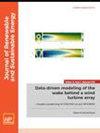基于时空信息集成方法的分布式光伏发电功率预测研究
IF 1.9
4区 工程技术
Q4 ENERGY & FUELS
引用次数: 1
摘要
分布式光伏发电可以有效利用闲置资源,减少碳排放。为了降低并网分布式光伏发电功率波动对电网运行的影响,本文同时利用功率序列的时间依赖性和气象数据的空间相关性,提出了一种具有时空信息的分布式光伏电站时间特征与空间关系融合的组合预测模型。首先,在时变预测研究中,提出了一种基于遗传算法-自然梯度增强的长短期记忆神经网络集成预测模型,该模型能有效拟合分布式光伏的多组时变特征。在空间相关预测研究中,通过κ相关系数选择影响光伏发电的气象数据,将目标电厂和空间参考电厂气象数据重构成二维矩阵,设计了二维卷积神经网络空间特征提取功率预测模型。最后,通过改进信息熵的多误差评价准则融合时间信息和空间特征两种预测模型的优点,构建并实现了分布式光伏电站高精度的时空信息组合预测模型。利用中国河北省光伏集群数据验证了本文预测模型的效果。研究结果表明,本文提出的组合时空信息模型的5个预测性能评价指标优于其他模型。本文章由计算机程序翻译,如有差异,请以英文原文为准。
Research on distributed photovoltaic power prediction based on spatiotemporal information ensemble method
Distributed photovoltaic power generation can efficiently utilize idle resources and reduce carbon emissions. In order to reduce the impact of grid-connected distributed photovoltaic power fluctuations on grid operation, this paper simultaneously exploits the temporal dependence of power series and the spatial correlation of meteorological data to propose a combined prediction model with temporal characteristics and spatial relationships fused for distributed photovoltaic power plants with spatiotemporal information. First, in the study of time-dependent prediction, we propose a long and short-term memory neural network ensemble prediction model based on genetic algorithm-natural gradient boosting, which efficiently fits multiple sets of temporal characteristics of distributed photovoltaic. In the study of spatial correlation prediction, the meteorological data affecting photovoltaic power generation are selected by κ correlation coefficients, the target power plant and spatial reference power plant meteorological data are reconstructed into a two-dimensional matrix, and a two-dimensional convolutional neural network spatial feature extraction power prediction model is designed. Finally, the advantages of the two prediction models of temporal information and spatial features are fused by multiple error evaluation criteria improved information entropy, and a distributed photovoltaic power plant is constructed and implements highly accurate spatiotemporal information combination prediction model. The effect of the forecasting model in this study is validated using the photovoltaic cluster dataset in Hebei Province, China. Compared with other models, the results of this study show that the five prediction performance evaluation metrics of the proposed combined spatiotemporal information model are better.
求助全文
通过发布文献求助,成功后即可免费获取论文全文。
去求助
来源期刊

Journal of Renewable and Sustainable Energy
ENERGY & FUELS-ENERGY & FUELS
CiteScore
4.30
自引率
12.00%
发文量
122
审稿时长
4.2 months
期刊介绍:
The Journal of Renewable and Sustainable Energy (JRSE) is an interdisciplinary, peer-reviewed journal covering all areas of renewable and sustainable energy relevant to the physical science and engineering communities. The interdisciplinary approach of the publication ensures that the editors draw from researchers worldwide in a diverse range of fields.
Topics covered include:
Renewable energy economics and policy
Renewable energy resource assessment
Solar energy: photovoltaics, solar thermal energy, solar energy for fuels
Wind energy: wind farms, rotors and blades, on- and offshore wind conditions, aerodynamics, fluid dynamics
Bioenergy: biofuels, biomass conversion, artificial photosynthesis
Distributed energy generation: rooftop PV, distributed fuel cells, distributed wind, micro-hydrogen power generation
Power distribution & systems modeling: power electronics and controls, smart grid
Energy efficient buildings: smart windows, PV, wind, power management
Energy conversion: flexoelectric, piezoelectric, thermoelectric, other technologies
Energy storage: batteries, supercapacitors, hydrogen storage, other fuels
Fuel cells: proton exchange membrane cells, solid oxide cells, hybrid fuel cells, other
Marine and hydroelectric energy: dams, tides, waves, other
Transportation: alternative vehicle technologies, plug-in technologies, other
Geothermal energy
 求助内容:
求助内容: 应助结果提醒方式:
应助结果提醒方式:


